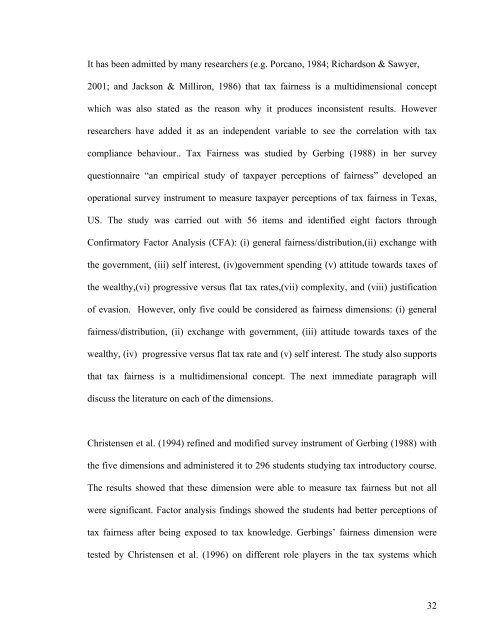1 CHAPTER 1: INTRODUCTION 1.0 Chapter ... - DSpace@UM
1 CHAPTER 1: INTRODUCTION 1.0 Chapter ... - DSpace@UM
1 CHAPTER 1: INTRODUCTION 1.0 Chapter ... - DSpace@UM
Create successful ePaper yourself
Turn your PDF publications into a flip-book with our unique Google optimized e-Paper software.
It has been admitted by many researchers (e.g. Porcano, 1984; Richardson & Sawyer,2001; and Jackson & Milliron, 1986) that tax fairness is a multidimensional conceptwhich was also stated as the reason why it produces inconsistent results. Howeverresearchers have added it as an independent variable to see the correlation with taxcompliance behaviour.. Tax Fairness was studied by Gerbing (1988) in her surveyquestionnaire “an empirical study of taxpayer perceptions of fairness” developed anoperational survey instrument to measure taxpayer perceptions of tax fairness in Texas,US. The study was carried out with 56 items and identified eight factors throughConfirmatory Factor Analysis (CFA): (i) general fairness/distribution,(ii) exchange withthe government, (iii) self interest, (iv)government spending (v) attitude towards taxes ofthe wealthy,(vi) progressive versus flat tax rates,(vii) complexity, and (viii) justificationof evasion. However, only five could be considered as fairness dimensions: (i) generalfairness/distribution, (ii) exchange with government, (iii) attitude towards taxes of thewealthy, (iv) progressive versus flat tax rate and (v) self interest. The study also supportsthat tax fairness is a multidimensional concept. The next immediate paragraph willdiscuss the literature on each of the dimensions.Christensen et al. (1994) refined and modified survey instrument of Gerbing (1988) withthe five dimensions and administered it to 296 students studying tax introductory course.The results showed that these dimension were able to measure tax fairness but not allwere significant. Factor analysis findings showed the students had better perceptions oftax fairness after being exposed to tax knowledge. Gerbings’ fairness dimension weretested by Christensen et al. (1996) on different role players in the tax systems which32
















